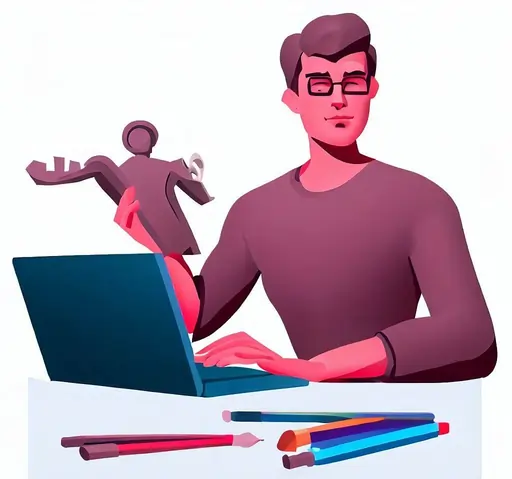Elevating Your Craft: Do Your Sculpture Assignments with Digital Sculpting Tools


The Advantages of Digital Sculpting
Explore the benefits of digital sculpting as we investigate how it transforms the approach that is taken to completing sculpture assignments and the manner in which they are finished. Learn more about the increased flexibility that digital sculpting provides, which includes freedom from physical constraints as well as an iterative design process that encourages experimentation. Find out how simple it is to make changes to your sculpting assignments, which will enable you to make efficient adjustments and refinements. In addition, it is important to have an understanding of the improved educational opportunities that are presented by digital sculpting. These opportunities include accessibility and affordability, real-time feedback, and the integration of traditional and digital techniques. Come along with us as we explore the world of digital sculpting tools and their potentially life-changing potential.
Precision and Control
Tools for digital sculpting provide an unmatched level of precision and control over your artistic creations, and they are becoming increasingly popular. When using more conventional approaches to sculpting, it can be challenging to make precise adjustments or undo mistakes. On the other hand, if you use tools for digital sculpting, you can easily make adjustments to your sculpture at any stage of the process. You have complete control over your artwork thanks to these tools, which enable you to zoom in on your sculpture, rotate it, and work with even the most intricate details with ease.
Time Efficiency
The process of building a sculpture from scratch by employing more conventional techniques can be a time-consuming one. It entails gathering the necessary materials, sculpting them, drying them, and then refining them. Tools for digital sculpting, on the other hand, cut the amount of time needed to create a sculpture by a significant amount. It is possible to engage in design exploration using a variety of virtual resources, such as virtual models, virtual materials, and virtual textures. In addition, the capability to undo and redo actions provides you with the flexibility to make speedy adjustments and rapidly iterate on your ideas.
Versatility and Flexibility
The use of digital sculpting tools gives you access to a diverse collection of features and functionalities, which in turn enables you to experiment with a wide variety of artistic styles and approaches. To visualise the effects of different materials, such as stone, metal, or clay, on your sculpture, you can simulate these materials by simulating different lighting conditions and experimenting with different lighting conditions. In addition, you can use these tools to work in both two-dimensional and three-dimensional spaces, giving you the flexibility to create sculptures that can be viewed from a variety of vantage points.
Getting Started with Digital Sculpting
Starting a digital sculpture project is an exciting journey that offers a myriad of creative opportunities. To start, you must pick the software that best suits your needs and preferences. For digital sculpting, popular options like ZBrush, Blender, and Mudbox provide strong tools and features. Knowing the software's fundamental tools and functionalities is crucial after you've chosen it. The fundamentals of digital sculpting can be learned from online tutorials, documentation, and video courses. Your creativity will soar if you comprehend ideas like working with brushes, making and editing surfaces, and applying textures. Spend time experimenting with various tools, brushes, and techniques because practise is essential to becoming an expert at digital sculpting. Start with easy tasks, then gradually push yourself with more challenging sculptures. Always remember to use tools like layers and sculpting history to iterate on your designs and perfect them. You can master the abilities required to be successful in the field of digital sculpting by exercising patience, perseverance, and an openness to learning.
Choose the Right Software
The first thing you'll want to do is choose the piece of digital sculpting software that's going to work best for you. On the market, one can choose from a number of different options, each of which comes with its own individual set of features and user interface. ZBrush, Blender, and Mudbox are examples of well-known software programmes that are used for digital sculpting. Do some research on these different software options, evaluate each one based on the functionalities it offers, and pick the one that best meets your needs and preferences.
Learn the Basics
After you have made your selection, it is time to become acquainted with the software's fundamental features, such as its tools and functionalities. Learn the fundamentals of digital sculpting by familiarising yourself with the various online tutorials, documentation, and video courses that are available. By gaining an understanding of the fundamental concepts, you will be able to unleash your creativity and make the most of the software. Some of these fundamental concepts include the manipulation of brushes, the creation and editing of surfaces, and the application of textures.
Practice, Experiment, and Iterate
Practise is absolutely necessary to become proficient in digital sculpting, just as it is with any other skill. Devote some of your time to experimenting with various tools, brushes, and artistic approaches. Begin with straightforward projects, and work your way up to more difficult sculptures as you go. Utilise the capabilities of the software, such as the layers and the sculpting history, to iterate on your designs and bring them closer and closer to perfection. It is important to remember that making mistakes is a necessary component of the educational process; therefore, you should not be afraid to do so.
Tips for Excelling in Digital Sculpting Assignments
There are a number of techniques and suggestions you can use to be successful in your digital sculpting assignments. First and foremost, thorough research and inspiration gathering are essential. Examine the creations of well-known sculptors, research various artistic movements, and become fully acquainted with the topic of your assignment. You can use this as a strong foundation and a source of inspiration for your own sculptures. Second, before using the digital sculpting software, planning and sketching are crucial steps. To visualise your sculpture and decide on its composition, form, and proportions, take your time creating paper or digital sketches of your ideas. It is also very helpful to ask for feedback from peers, teachers, or online communities. It will be helpful to you to identify areas for improvement and gain new perspectives if you share your work and are open to constructive criticism. And finally, accept the iterative process. Utilise criticism to improve your sculpture's textures, details, and overall aesthetics. Keep in mind that excellence in digital sculpting requires time, effort, and a desire to develop as an artist.
Research and Gather Inspiration
Before beginning any assignment, you should first complete in-depth research on the topic at hand. Research the works of well-known sculptors and become familiar with a variety of artistic styles. Because of this, you will have access to a wealth of ideas and inspiration that you can incorporate into your own sculptures. In addition, you should think about the requirements and guidelines for the assignment to ensure that your artwork meets the criteria that have been provided.
Plan and Sketch
In spite of the fact that digital sculpting makes room for improvisation and exploration, it is absolutely necessary to have a well-defined strategy in place before beginning work in the software. Whether on paper or with the help of digital tools, spend some time sketching out your ideas. Because of this, you'll have an easier time visualising your sculpture and coming to educated conclusions about its composition, form, and proportions. Your sculpting process will be more streamlined as a result of a well-thought-out plan, and the resulting artwork will be more cohesive and impactful.
Seek Feedback and Iterate
During the process of creating a digital sculpture, it is important to solicit feedback from your colleagues, instructors, and members of online communities. Sharing your work and being open to receiving feedback in the form of constructive criticism will assist you in determining areas of improvement and expanding your worldview. Utilise this feedback to iterate on your sculpture, improving the details, textures, and aesthetics as a whole. Keep in mind that the iterative process is absolutely necessary in order to produce high-quality artwork.
Conclusion
To sum up, digital sculpting tools have completely changed how we approach sculpture assignments by providing accuracy, time-saving features, versatility, and flexibility. You can use digital sculpting to unleash your creativity and create captivating artwork by picking the right software, learning the fundamentals, and practicing frequently. To perfect your sculptures and complete your assignments to the highest standard, remember to plan ahead, conduct research, get feedback, and iterate. Accept the journey of digital sculpting and push the limits of your artistic expression by experimenting with various tools, techniques, and styles. You can make breathtaking sculptures that reflect your individual artistic vision if you put effort, passion, and a willingness to learn into them. Therefore, don't be afraid to explore the world of digital sculpting and learn about the limitless opportunities it holds for your creative endeavors. Happy modelling